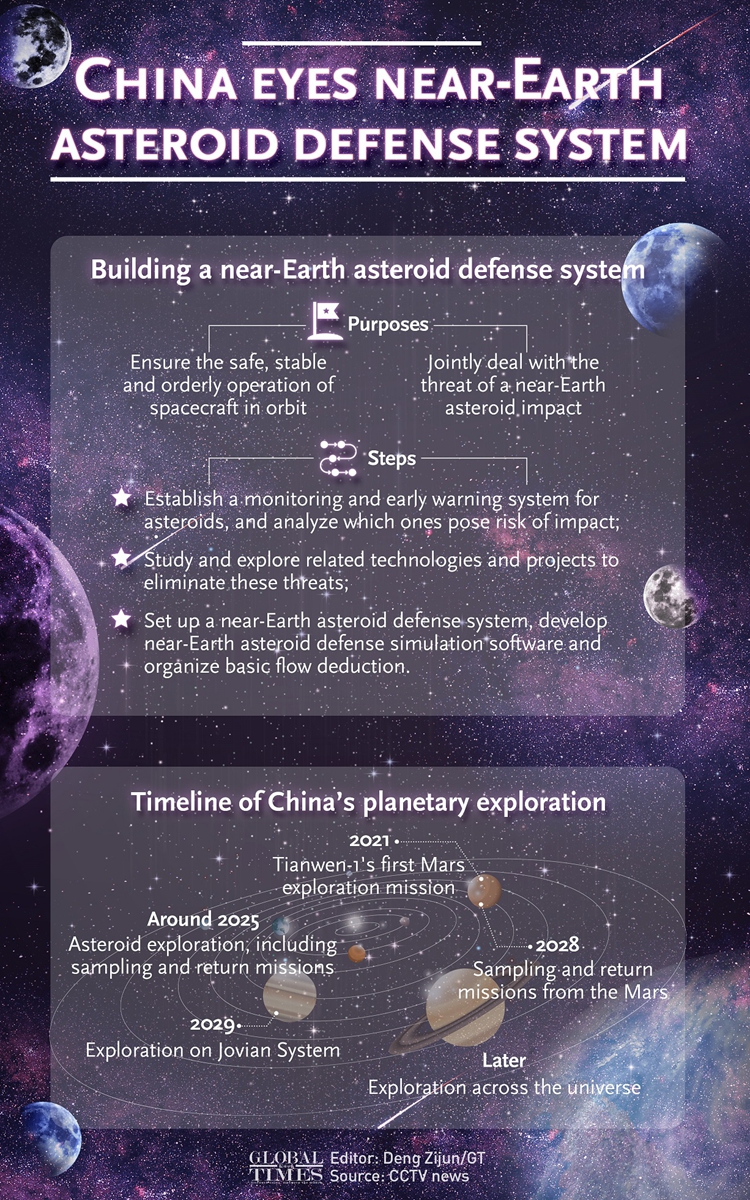
Poster of the 2022 Space Day of China Photo: Courtesy of CNSA
Having bagged numerous milestones in the space sector in 2021 and in the middle of a busy schedule for China's space station construction missions, China kick-started its annual Space Day of China celebrations themed "Space inspires dreams" on Sunday in South China's tropical island province of Hainan, home to Wenchang Spacecraft Launch Site, known as the home port of space station launch missions.
China designated April 24 as Space Day of China in 2016 to mark the anniversary of the country's first satellite launch, Dongfanghong-1 in 1970.
During an inspection tour in Wenchang prior to the Shenzhou-13 crew's return from a six-month mission in the Tiangong Space Station, Chinese President Xi Jinping demanded efforts to elevate the spacecraft launch site into world-leading standards on April 12.
Xi, also general secretary of the Communist Party of China Central Committee and chairman of the Central Military Commission, inspected the launch tower and other facilities. He spoke highly of a series of key space missions launched from the site, including the launch of the space station's core module, the Tianhe, the Chang'e-5 lunar mission and the Tianwen-1 Mars probe.
Xi noted that Wenchang is the launch site for China's new-generation of high-thrust carrier rockets and the bridgehead of the country's deep-space exploration.
Zhang Rongqiao, chief designer of China's Tianwen-1 Mars probe, Wang Yaping, the star-picking mom and a member of the just-returned Shenzhou-13 mission crew, and Shan Jixiang, former curator of the Palace Museum, were named as ambassadors for China's space industry.
The United Nations Under-Secretary-General Atul Khare, Director General of the European Organization for the Exploitation of Meteorological Satellites Phil Evans, Russia's space agency Roscosmos Director Dmitry Rogozin, and officials with Pakistan's space agency Space and Upper Atmosphere Research Commission sent congratulations to China for Space Day on Sunday.
One launch per weekChina successfully conducted 55 orbital launches in 2021, and China will further advance its pursuit of space dreams, planning more than 60 launches in 2022, Wu Yanhua, deputy head of the China National Space Administration (CNSA,) told the Global Times on the sidelines of the event.
The 2022 launch schedule includes six for the in-orbit building of the country's first space station including launches for the Tianzhou-4, Tianzhou-5 cargo spacecraft and Wentian and Mengtian laboratory modules. China plans to launch space infrastructure satellites including the Gaofen-01A remote sensing satellite as well as ones tasked for environment monitoring services, per the CNSA deputy head.
Wu revealed that China will officially launch research and studies for its Phase-4 lunar explorations, including the launches of the Chang'e-6, -7, and -8 probes to the moon, during which work on tackling key technology issues and those related to the construction of the China-Russia proposed International Lunar Research Station (ILRS) would be carried out.
Chang'e-6 is planned as a lunar sampling and return mission from the dark side of moon and China will invest in efforts in the proposition of building a satellite constellation around the moon with the functions of both communication and navigation in space.
Chang'e-7 will probe the lunar polar region, especially looking into water distribution on the moon. These two missions will be launched around 2025, during which the development for the Chang'e-8 mission will start simultaneously, Liu Jizhong, director of the China Lunar Exploration and Space Engineering Center, said during a press conference in January with the release of the long-anticipated fifth edition of a new white paper, titled China's Space Program: A 2021 Perspective.
China's Chang'e-7 mission includes an agreement with Russia's Luna-26 mission, and the two sides will explore the moon together, Liu said.
Chang'e-8's launch, according to Liu, could be expected before 2030, and would involve verifying key technology for the lunar station.
Pang Zhihao, a Beijing-based senior space expert, predicted that to meet such requirements, multiple relay satellites with communication and navigation functions would be launched into lunar orbit. They are to support the future Long March-8 carrier rocket for the building of the ILRS.
China, in the next five years, plans to complete key technology work for major missions such as an asteroid probe and a Mars sampling and return missions. The development of a heavy-lift carrier rocket and a new-generation manned launch vehicle will also be carried out in this period.
China is also planning to explore the edges of the solar system and other more distant space in the long term, including sample retrieval from Mercury, and probing Jupiter's satellite moons, Wu added.
Wu stressed that China's space exploration would always adhere to the principle of joint consultation, joint construction and sharing, with an emphasis on openness and win-win purpose, and always be devoted to the building of a shared future of mankind in space.

Graphic: Deng Zijun/GT
Eyeing asteroid defense To practice these principles, Wu told the Global Times that China is eyeing building a system for near-Earth asteroid defense, organizing the drafting of development plans and developing near-Earth small celestial body defense simulation software.
"It is to contribute China's wisdom to the human beings' joint response to the threat of small near-Earth objects, taking on the responsibility of a great country and safeguarding the safety of Earth and peaceful development of humanity together with other countries," Wu underscored.
A ground-based and space-based monitoring and warning system for asteroids will be set up to catalog and analyze asteroids that pose a threat to humanity's space activities, and then relevant technology and engineering will be developed to dispel the threats.
China will hopefully carry out a technical experiment as early as 2025 on a threatening asteroid by closely tracking and attacking it to change its orbit, Wu disclosed on Sunday.
Mission insiders revealed to the Global Times on Sunday that the system is currently at the project establishment phase and being reviewed for approval, which involves the close coordination of multiple departments.
Song Zhongping, a military expert and space observer, told the Global Times on Sunday that currently the US and Russia are also building asteroid monitoring systems, and China's defense system could be an important supplement in addressing the threats of asteroids hitting Earth.
"This is another practical solution that China proposes to build a community with a shared future for mankind, and it is the duty for a major space power to protect mankind from possible disasters that could end the entire human civilization," Song said.
The latest asteroid impact incident happened in 2013 in Russia's Chelyabinsk, when an approximately 18 meter-diameter near-Earth asteroid entered the atmosphere and exploded 30 kilometers above the ground. Its power equaled to about 30 atomic bombs, which caused over 1,500 injuries and damaging over 3,000 houses.





